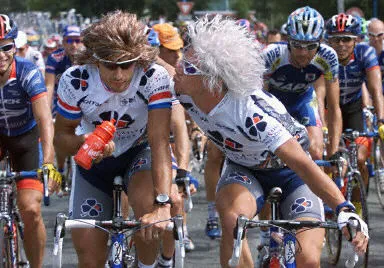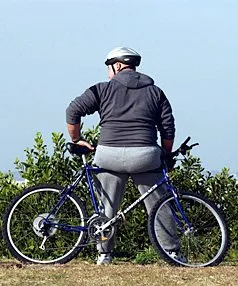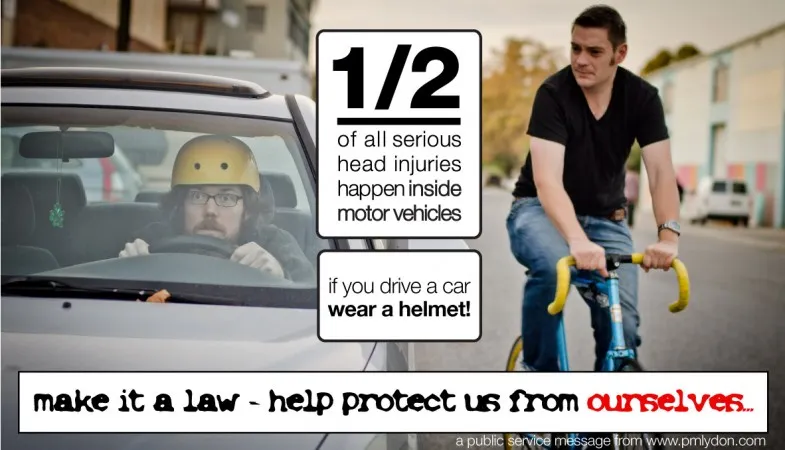New Zealand is the only country in the world to force cyclists to wear helmets

Now that riding electric scooters can save the planet from "climate change" and every righteous eco-warrior wants to do their bit to "save the planet" by riding a bicycle, strangely enough helmet laws have been largely forgotten, the roads are full of unco cyclists without helmets, alongside complete numpties totally out of control on electric scooters, but none of them are being fined for riding without a helmet.
Back when mountain bikers were "dangerous outlaws who didn't pay road taxes" we were getting chased and ticketed by cops all the time. Even on occasion head high tackled off our bikes or rammed by cop cars, all in the name of "enforcing the law"
New Zealand is still the only country in the world to have national bicycle helmet laws, (Australia still does in most but not all states) and back in the day I was vocally opposed to them. Here are some of my rantings from back when I used to get all wound up about this sort of thing (these days I don't really give a toss).

NEW ZEALAND'S HELMET LAWS ARE A MISTAKE
Before criticizing bicycle helmet legislation, I would like to emphasize an important point. Helmets can save you from getting your brains scrambled, and I generally recommend you wear one. Having written off three helmets, it’s fairly safe to say I would be something of a cabbage without helmets (some people say I’m a cabbage anyway).
Another point I would like to make, is what ever your opinion is on helmet laws, it’s not worth stressing about – really it’s not that important, go and enjoy riding your bike. I originally wrote about helmet laws to help people see that like many issues, it’s not really all black and white.
Helmet laws are not helmets – they are laws, and like most laws, there is an element of bullshit involved. While wearing a helmet is usually a good idea, in the bigger picture of social health on a whole, the statistics just don’t stack up. Why? Because compulsory helmets significantly reduce the number of people using bikes for casual transport, by up to around 40%.
As casual use is potentially the biggest use of bikes, and this type of use has such a positive effect on health of inactive people, statistically it overrides the negative health effects of turning a few of them into cabbages. (e.g. Say 10 avoid heart attacks for each one that gets munted by a car). Statistics won’t help you once you are a cabbage, but then neither will they help you after a heart attack. There are two sides to most arguments…
Some of the strongest supporters of helmet legislation are mountain bikers, but what a lot of them seem to miss is that no one is saying “don’t wear a helmet”, and that wearing a helmet while mountain biking off road is not compulsory anyway. (Road rules only apply to roads). What we are discussing here is a social policy, aimed mainly at casual cyclist, rather than cycle enthusiasts, and in terms of “the greater good” this law doesn’t stack up.
Many people argue that as tax payers they should be protected from funding the stupidity of others. And that’s reasonable, but I would say that legislating against a healthy recreational activity, potentially dangerous only to ones own health, is completely out of line in a country where smoking, overeating, drinking alcohol, and playing rugby (with or without a helmet), are all perfectly legal.
Does anybody seriously think that the long term dangers or social costs of riding without a helmet are greater than that of smoking cigarettes? The costs to tax payers from illnesses caused by the consumption of soft drinks such as those made by Coca Cola, are many thousands of times greater than costs created by cycling head injuries. And illnesses caused by Aspartame and Nutrasweet consumption are causing massive expenses to tax payers. But no-one has banned diet coke…
Driving a car without a helmet carries similar risks to riding a bike without one, (yes that’s per hour, not per kilometer) and the people who support bike helmet laws do not use helmets when they drive. Having had head injuries in a car without a helmet and on a bike with one, all I can say for sure is that it hurts either way.

It’s safer to wear a wig
Cyclists may be safer wearing a long-haired wig than a helmet, research suggests.
In England, a Bath University study found drivers gave a wider berth to cyclists with long hair than those wearing helmets.
The study, by psychologist Dr Ian Walker, also found bare-headed cyclists were given more room than those wearing helmets.
Walker used a bicycle fitted with a computer and an ultrasonic distance sensor to record data from more than 2500 overtaking motorists. He wore a helmet half the time.
During his research, he was struck by a bus and a truck – both times while wearing a helmet.
In research to be published in the Accident Analysis and Prevention journal, Walker found drivers, on average, passed 1.33m from his bicycle. However, when he wore a long-haired wig – to give the impression he was female – overtaking drivers gave him an extra 14cm. By contrast, when he was wearing a helmet, they passed 8.5cm closer. Larger vehicles also narrowed the gap, with trucks passing 19cm closer than cars and buses, 23cm closer.
He wanted to do more research to understand why drivers appeared to give female cyclists such a wide berth. It was possible they were seen as less predictable than male riders because they were not seen on the road as often as male cyclists.
He suggested drivers saw cyclists with helmets as more serious, experienced and predictable than those without, and therefore needing less space when overtaking.

Helmets a turn-off for cyclists
They are designed to prevent serious head injuries, but it seems helmets are a turn-off for would-be cyclists worried about messing up their hair.
A Massey University study has found the law requiring cyclists to wear helmets acts as a deterrent for some potential pedal-pushers. Women and young people in particular said they avoided cycling because of the effect on their hair-styles.
“What this research suggests is that if the Government wants to achieve their policy of having more people cycling as a mode of transport, they may want to review the current law on cycle helmets,” said researcher Kane Hopkins, of Massey’s communication and journalism department. The environmental benefits of having more people cycling might be greater than the safety benefits provided by helmets, he said.

The Hypocrisy of Cycle Helmet Laws

The British Medical Association (BMA) rejected the idea that wearing cycle helmets should be compulsory.
Canada: Helmet Law For Alberta? Maybe not…

Head injuries and bicycle helmet laws
The first year of the mandatory bicycle helmet laws in Australia saw increased helmet wearing from 31% to 75% of cyclists in Victoria and from 31% of children and 26% of adults in New South Wales (NSW) to 76% and 85%.
However, the two major surveys using matched before and after samples in Melbourne (Finch et al. 1993; Report No. 45, Monash Univ. Accident Research Centre) and throughout NSW (Smith and Milthorpe 1993; Roads and Traffic Authority) observed reductions in numbers of child cyclists 15 and 2.2 times greater than the increase in numbers of children wearing helmets. This suggests the greatest effect of the helmet law was not to encourage cyclists to wear helmets, but to discourage cycling.
In contrast, despite increases to at least 75% helmet wearing, the proportion of head injuries in cyclists admitted or treated at hospital declined by an average of only 13%. The percentage of cyclists with head injuries after collisions with motor vehicles in Victoria declined by more, but the proportion of head injured pedestrians also declined; the two followed a very similar trend. These trends may have been caused by major road safety initiatives introduced at the same time as the helmet law and directed at both speeding and drink-driving. The initiatives seem to have been remarkably effective in reducing road trauma for all road users, perhaps affecting the proportions of victims suffering head injuries as well as total injuries.
The benefits of cycling, even without a helmet, have been estimated to outweigh the hazards by a factor of 20 to 1 (Hillman 1993. Cycle helmets-the case for and against. Policy Studies Institute, London). Consequently, a helmet law, whose most notable effect was to reduce cycling, may have generated a net loss of health benefits to the nation. Despite the risk of dying from head injury per hour being similar for unhelmeted cyclists and motor vehicle occupants, cyclists alone have been required to wear head protection. Helmets for motor vehicle occupants are now being marketed and a mandatory helmet law for these road users has the potential to save 17 times as many people from death by head injury as a helmet law for cyclists without the adverse effects of discouraging a healthy and pollution free mode of transport.

Evidence for the efficacy of helmets in preventing serious injury is contradictory and inconclusive.
In general, analyses of the relative merits of different bike safety interventions put helmets low down, because no helmet will reduce the probability of crashing (and there is some evidence that helmets may increase this likelihood).
Proactive measures including bike maintenance and riding skills are far more important. Although the link is not causal, it is observed that the countries with the best cycle safety records (Denmark and the Netherlands) have among the lowest levels of helmet use. Their bicycle safety record is generally attributed to public awareness and understanding of cyclists, education, and to some extent separation from motor traffic.
Population studies compare changes in helmet use and injury rates in a single population over time, most notably where helmet laws have resulted in large changes in a short time. A review of jurisdictions where helmet use increased by 40% or more following compulsion showed no measurable change to the proportion of head injuries among injured cyclists.
The definition of injury is also open to debate, and injury figures are acknowledged to be inaccurate. Research by TRL and others shows that reporting of injuries is related to severity: fatal injuries are almost always reported, in the developed world, but 90% or more of lesser injuries go unreported.
Recent research on traumatic brain injury adds further confusion, suggesting that the major causes of permanent intellectual disablement and death may well be torsional forces leading to diffuse axonal injury (DAI), a form of injury which helmets cannot mitigate. Helmets may increase the torsional forces by increasing the distance from the extremities of the helmet to the centre of the spine, compared to the distance without a helmet.
There is a long-running argument over the use, promotion, and compulsion of cycle helmets. Most heated controversy surrounds laws making helmet use compulsory, particularly regarding the substantial disparity between claimed injury savings in small-scale prospective studies, and later, more comprehensive studies, particularly from jurisdictions which have used compulsion to substantially raise helmet use over a very short period. Helmet use in New Zealand, for example, rose from 43% to over 95% in under three years, with no measurable change in head injury rates.
Many of the most vocal proponents of helmets are not themselves cyclists.
Overall, according to CTC, the UK’s national cyclists organisation, “the evidence currently available is complex and full of contradictions, providing at least as much support for those who are sceptical as for those who swear by them.”
Mandatory bicycle helmet laws have been linked to a reduction in the number of cyclists. For example, when mandatory bicycle helmet laws were enacted in Australia, slightly more than one third of bare-headed cyclists ceased to ride their bicycles frequently. The reduction in the number of cyclists is likely to have a greater negative impact on the health of a population, than would have resulted from any increase in injury. The long term health benefits of bicycle use are manifold and extensively documented, and so any reduction in bicycle activity will likely have a negative impact on the overall health of a population.
As well as being an extra expense, cycle helmets make cycling less convenient; they are bulky and often cannot be stored securely with bikes. They are incompatible with some hairstyles, forcing bicycle users to recreate their hairstyle after each journey.
Cycle helmet promotion or high levels of use may deter cycling by reinforcing the misconception that bicycling is more dangerous than traveling by passenger car.
All of these factors can lead to an increased risk for those cyclists remaining on the road, due to a “safety in numbers” effect. According to one study, the probability of an individual cyclist being struck by a motorist declines with the 0.6 power of the number of cyclists on the road. This means that if the number of cyclists on the road doubles, then the average individual cyclist can ride for an additional 50% of the time without increasing his probability of being struck. It is thought that the increased frequency of motorist-cyclist interaction creates more aware motorists.
Many believe that a helmet can save a cyclist’s life, an idea which is repeatedly asserted in debate. There is no known evidential basis for this claim and there are no known cases where mass helmet use has actually reduced the number of cyclists’ deaths or serious head injuries. Association with increased risk of death has been reported.
It is likely that helmets could prevent a significant number of minor cycling injuries but the overall safety benefits are inconclusive; this is thought to be in part due to risk compensation behaviour. A cost-benefit analysis of the New Zealand helmet law showed that the cost of helmets outweighed the savings in injuries even taking the most optimistic estimate of injuries prevented.
While a helmet may mitigate the effects of a fall or collision, other factors (such as maintenance, road conditions, and driver behaviour) are more important for reducing the chance of such accidents in the first place. In general, the value of bicycle helmets has been systematically overstated.
* Risk compensation: helmeted cyclists may ride less carefully; this is well supported by evidence for other road safety interventions such as seat belts and antilock brakes.
* Recent evidence suggests vehicles pass helmeted cyclists with measurably less clearance (8.5 cm/3.5″) than that given to unhelmeted cyclists (out of an average total passing distance of 1.2 to 1.3 metres), indicating additional risk compensation by motorists too.
Helmet use has increased significantly in many, but not most, jurisdictions since the 1980s, primarily because of helmet promotion and compulsion laws. The following countries have mandatory helmet laws, in at least one jurisdiction, for either minors only, or for all riders: Australia, Canada, Finland, Iceland, USA, and New Zealand.
In the U.S. 21 states have mandatory helmet laws. An analysis of helmet laws in the British Medical Journal showed that these laws have failed to yield measurable reductions in head injuries. The major documented effect of helmet laws is to reduce cycle use.
Helmet promoters routinely make claims which manufacturers cannot, due to truth in advertising restrictions. Promotion campaigns are often supported and/or funded by manufacturers. Bell, one major helmet manufacturer, supports both helmet promotion and, through its Legislative Assistance Programme, laws. The major problem with helmet promotion, from the point of view of cycle activists, is that in order to present the idea of a “problem” to match the solution they present promoters tend to overstate the dangers of cycling. Cycling is, according to the evidence, no more dangerous than being a pedestrian. In fact, helmet compulsion in cars would be far more effective at reducing injuries than on bicycles.
Cycling as a dangerous activity. Ordinary cycling is not demonstrably more dangerous than walking or driving, yet no country promotes helmets for either of these modes.Cycle helmet use correlates inversely with the level of cycling in a given country.
Detailed analysis of hospital admissions data also fails to support the idea that cycling is unusually dangerous: a study in the UK found that the proportion of cyclist injuries which are head injuries is essentially the same as the proportion for pedestrians at 30.0% vs. 30.1%.
Overall, cycling is beneficial to health – the benefits outweigh the risks by up to 20:1. Critics assert that anything which jeopardises that benefit should be carefully weighed to ensure it is likely to achieve some meaningful benefit in turn. Thus far, no helmet law has been shown to do that.
For an extensive list of references see Wikipedia
Chris Boardman on Helmets
My objective here is to get people to consider the real issues in a larger context. Should Andrei Kivilev’s death (a professional rider who died of head injuries after crashing without a helmet in 2003) be considered a tragic accident or a needless waste? I think ‘Both’ is the answer. He, like the rest of us, had a choice in whether to use a helmet or not, he chose not to. But ponder this; cycling is the only sport I can think of involving this level of speed, in which helmets are not a mandatory requirement. It’s up to you to decide where to draw your line; you don’t have to wait for someone to do it for you.

Here’s a site advocating the boycotting of Bell and Giro Helmets, because of their misleading advertising campaigns. While I partly disagree with the sites aim – Bell and Giro make some of the best helmets, and if you are going to wear one, then I recommend those two brands. But much of the other background information on the site backs up the content here. Have a look at Bell Helmets Campaign of Terror
An example of how helmets protect cyclists
Having had cops drive up onto the footpath on two occasions and attempt to ram me off my bike with their cars, and having had one of my friends head high tackled clean off his bike on a busy street for not wearing a helmet, I can really relate to this story – give a fascist puppet an excuse, and he will behave like a fascist puppet…
Cyclist pepper-sprayed for not wearing helmet
A Nelson cyclist without a helmet who was pepper-sprayed and then rammed into a bank by a police officer in a patrol car has told a court the officer was aggressive towards him.

Posted from my blog with SteemPress : http://www.frot.co.nz/design/new-zealand/make-them-wear-helmets/
